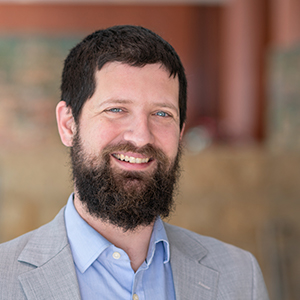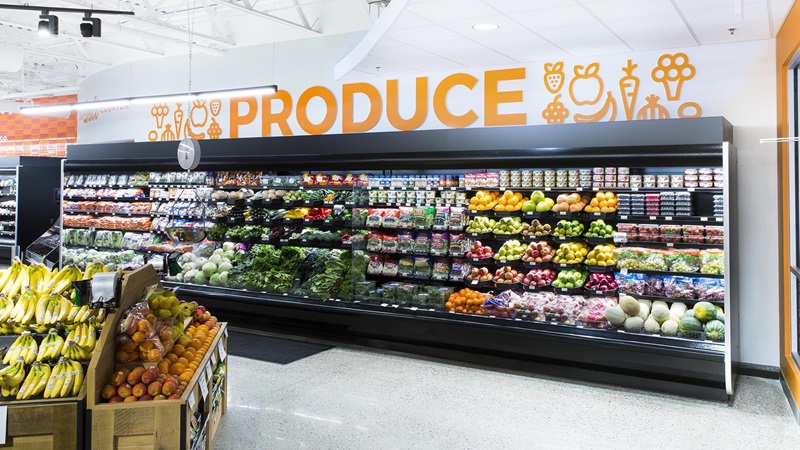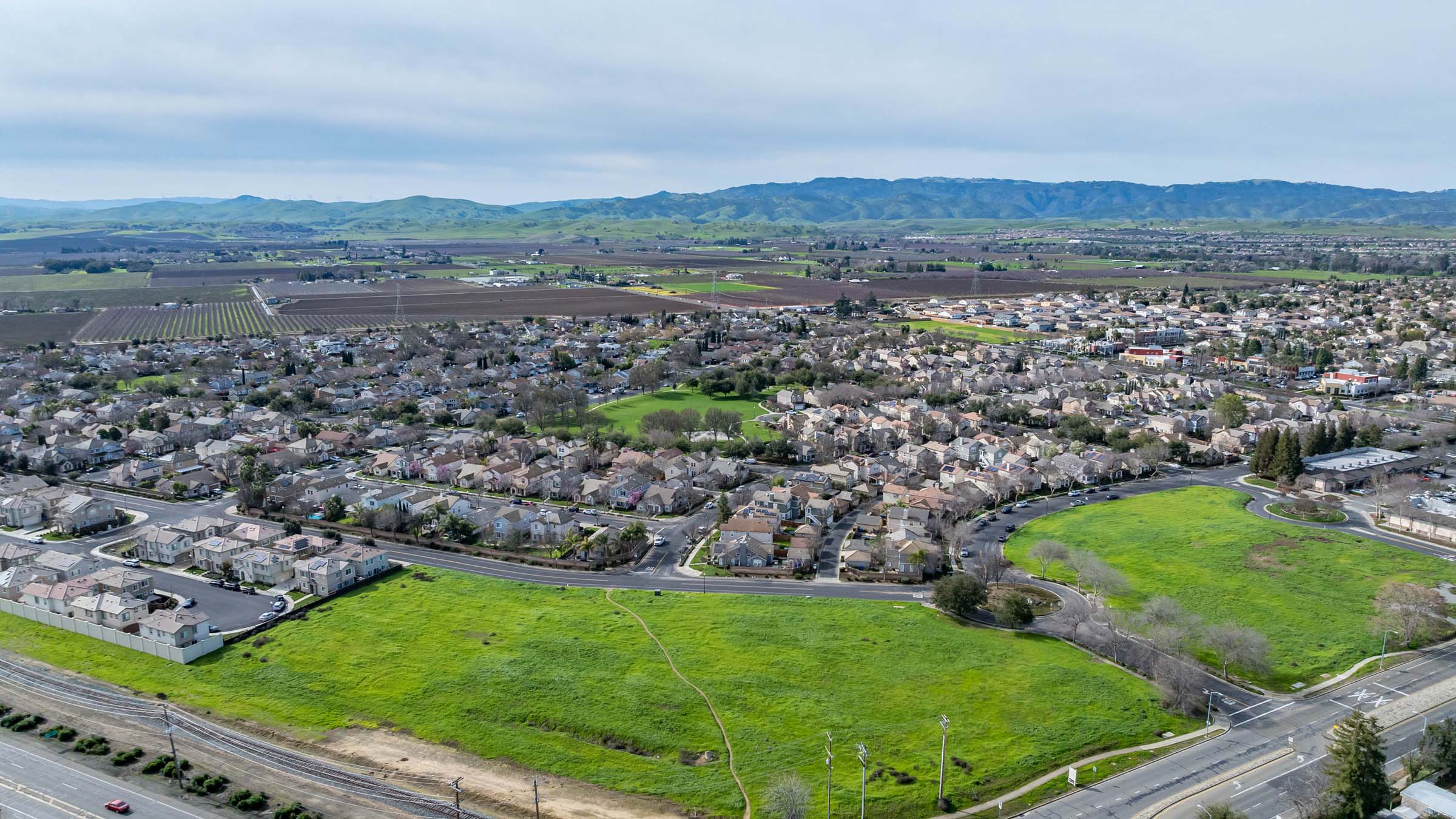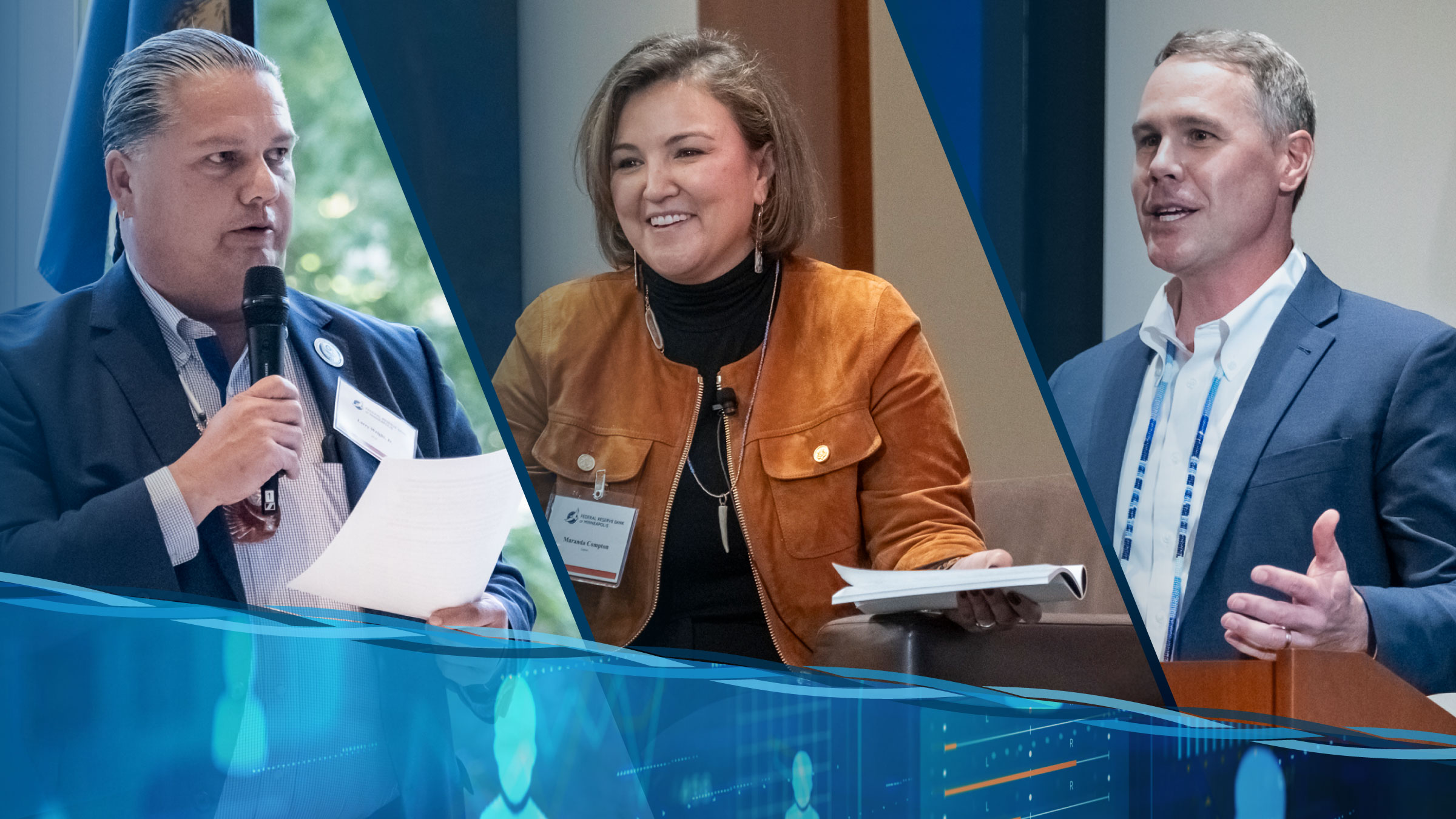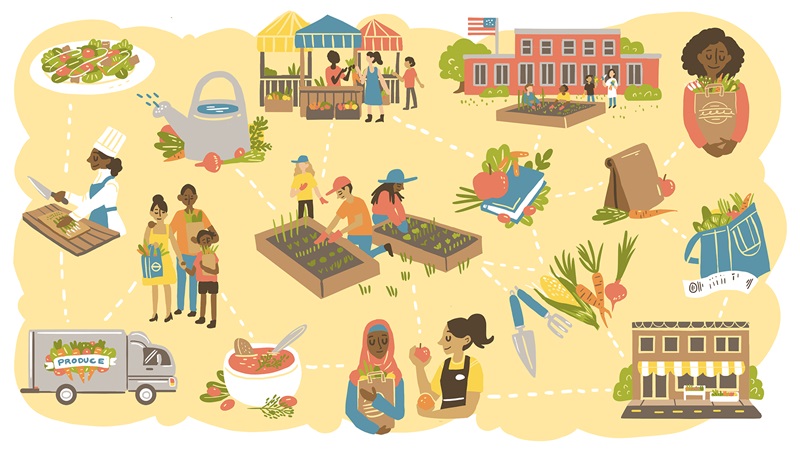
Tasha Powell is a lifelong resident of North Minneapolis who remembers walking to a thriving Broadway Avenue as a child. As she strolled down the retail corridor with her mother, they’d have their pick of grocery stores and restaurants that operated alongside other merchants. But as she grew up, Powell watched many of the institutions on Broadway follow her white neighbors into the suburbs.
Today, many of the neighborhoods in North Minneapolis—the quarter of the city that lies north of downtown and west of the Mississippi River—meet the federal definition of a food desert, or a geographic area where residents have limited or no access to grocery stores. The categorization considers both the location of fresh food and the income level of families in a neighborhood.1 (For a more detailed definition, see the “What is a food desert?” sidebar below.)
Areas in North Minneapolis tend to qualify on both fronts: households are more likely to have a low median income compared to the rest of Minneapolis and generally have poor access to healthy food. Until last year, North Minneapolis had only one full-service grocery store. Many Northside residents spend lots of time taking long bus rides or drives to the suburbs to find fresh produce and affordable staples. (To learn about the newest full-service grocery option, see the “New Northside market offers fresh food and promising pathways” sidebar below.)
While much of North Minneapolis qualifies as a food desert, the area might also qualify as a food swamp—that is, a geographic area that’s saturated with sources of unhealthy food, such as fast food franchises. Research on food swamps is relatively new, but driving around North Minneapolis, the phrase makes intuitive sense, as there seems to be an abundance of cheap and convenient food sellers offering items loaded with empty calories.
The grocery-shopping trips by residents and resulting flow of dollars from the neighborhood have an impact on the economy of the Northside. By one estimate, people in North Minneapolis spend roughly a third of their grocery money at convenience stores or outside of their neighborhood.2 The Northside Economic Opportunity Network (NEON), a nonprofit business development organization headquartered on Broadway Avenue, cites other research showing that $7 million per year in money spent on food leaves the neighborhood altogether. (For more on this, see our June 2016 interview with NEON president Marcus Owens, via the sidebar at right.)
Powell now works alongside her neighbors to bring healthy food options—and the economic opportunities that come with them—back to her home turf. She is a co-founder of Appetite for Change (AFC), a nonprofit social enterprise3 that uses food as a tool for creating health, wealth, and social change. The organization is one of several with deep roots in the community that have been planting and tending to seeds in North Minneapolis, both literally and figuratively.
“People on the Northside want to cook, we want to eat, we want good recipes,” Powell says. “We want better quality food in our groceries and restaurants. And we want community ownership at every level of our food system.”
Focusing on food systems means that AFC looks beyond the food on Northsiders’ plates and thinks about the entire journey the meal took to get there: Who grew the food? Who distributed it or processed it? Who prepared it? Where did the diner buy it? And did the diner’s money wind up reinvested in the community, or did it follow the course of historic disinvestment from North Minneapolis?
—Tasha Powell, Appetite for Change
To consider the whole journey, AFC brings together backyard gardeners, upstart entrepreneurs, and a diverse network of supporters in coalition-oriented work that amplifies their individual strengths. Their big-picture thinking is part of a broader trend among groups that focus on access to healthy food. And along with other nonprofits, funders, and the public sector, they are starting to change the food landscape of North Minneapolis.
Food-oriented partnerships on the Northside have resulted in a dizzying array of tools. The details, scope, and structures of each effort may differ, but the successful ones share a few things in common. They begin by listening to their community, they leverage support from partners and funders, and they capitalize on opportunities for alignment and efficiency.
Community empowerment through food advocacy
Fresh, healthy food options may be rare in North Minneapolis, but for many residents, that isn’t due to a shortage of opportunities for improvement. Michael Chaney started Project Sweetie Pie in 2010 after seeing a potential tool for healthy food access, workforce development, and empowerment in an abandoned greenhouse.
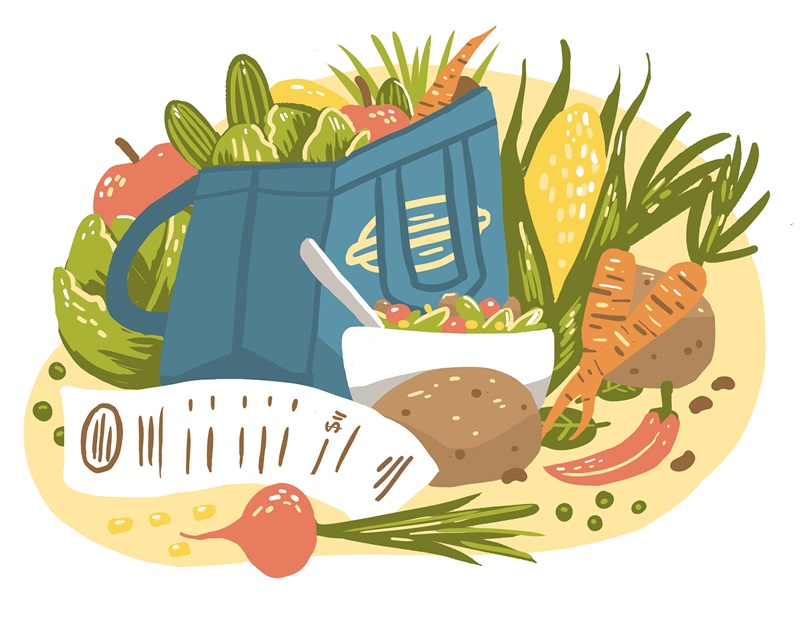
Chaney was involved in a movement that year that convinced Minneapolis Public Schools not to close North Community High School, which is located in the heart of the Northside’s Near North Neighborhood. During that effort, he learned that North High had a greenhouse that hadn’t been used for years. A light bulb switched on for Chaney, who grew up on a farm in Shell Lake, Wisconsin. He reached out to the owners of a local gourmet catering company and asked if they’d be interested in buying sweet potatoes grown by high schoolers.
The caterers said yes, and Chaney pulled together school officials and University of Minnesota Extension officers to make his vision a reality. The program at North High has been going strong since then. This year, 22 students are earning credit as they study food systems, learn how to grow food, and meet leaders of the local food movement. The school now has access to a hoop house, raised beds, and an aquaponics project.
The North High project still exemplifies the approach the organization takes to using food as a community development tool. Since establishing its high school programs, Project Sweetie Pie has, among other endeavors, led an effort to find financing for a large community greenhouse near the Northside’s largest park, advocated for funding everywhere from the Minneapolis Park Board to the U.S. Capitol, and taught classes to Northsiders on composting and farming techniques. And the organization has site control of 25 gardens around North Minneapolis.
Community-driven cooking
AFC, the nonprofit that Tasha Powell co-founded, began its work by establishing the Community Cooks program, which brings together community members to learn more about making healthy food at home—and to talk about what’s going on in their neighborhoods.
“We started out by bringing people together to cook and eat, to talk about change they wanted to see in themselves and in their community,” says Michelle Horovitz, another AFC co-founder and the organization’s executive director.
Powell says that many of the 300 Northsiders who participated in the first round of the program initially had trouble imagining how the food landscape in North Minneapolis might look any different. They’d become so used to driving across town to buy fresh meat or produce that they hadn’t given it a second thought. But once AFC started asking the right questions, people opened up. The voices at Community Cooks have driven the AFC agenda ever since. The organization now brings Community Cooks conversations to other neighborhoods and has tailored versions of the program to support young children and their mothers, youth, families, and preschoolers.
A third co-founder of AFC and its current director of education and training, Princess Titus, says that a community-driven approach has been crucial to the organization’s success.
“Instead of coming into a community and criticizing people for what they eat, we show up with cutting boards and ingredients and cook together,” Titus says. “It connects people to strangers, regardless of where they come from.”
Horovitz emphasizes the importance of making sure that the food being shared and the people delivering the program are grounded in the community.
“People are more open to information when it comes from someone who has shared similar life experiences, like people they might see around the neighborhood,” she adds. “If programs aren’t designed by the people they might see at the grocery store or around the community, the food might seem too unfamiliar, or the nutritional information might be delivered in a way that is less impactful.”
—Michelle Horovitz, Appetite for Change
Funding and advocating for food systems
Project Sweetie Pie and AFC have received support from the local philanthropic and public sectors to strengthen food systems in low-income communities. In some cases, the process for grantmaking by funders reflects the broader community context and roots of the organizations they are supporting.
The Full Lives program, helmed by the Greater Twin Cities United Way and funded by General Mills, offers one example. Launched in March 2017, Full Lives is a $1.5 million investment in community food-systems work in North Minneapolis taking place over the next two years. Grants will support 14 different projects at 11 different nonprofit organizations working at every stage of the food cycle.
The grants were made after a six-month process that involved meeting with more than 40 community leaders and working to understand the current issues, community aspirations, and historical context that contributed to the food desert status of North Minneapolis.
“Rather than making several individual grants to food access or equity organizations, our thinking was that we should take a community food-systems approach,” says Louise Iverson, senior program manager at the General Mills Foundation. “Bringing multiple organizations together will build even more support for scaling up of community-driven, community-based efforts.”
Alyssa Banks, the manager of Greater Twin Cities United Way’s food security investments, including Full Lives, says the grant program was designed to build off existing community efforts by taking a holistic “ecosystems” approach.
“Community food systems work is complex, multi-faceted, and interconnected. It’s about helping people access and understand healthy food,” she says. “But it’s also about weaving food access work to community infrastructure development and local economies by supporting people’s ability to gain job skills and make a living. As funders, we can help to support equity and enable change through strategic program investments that also strengthen local community leadership, effective grassroots organizing, and advocacy.”
—Alyssa Banks, Greater Twin Cities United Way
One of the projects funded by the initiative is the Northside Fresh Coalition. Founded in 2008 and currently led by AFC, the coalition brings together Northside residents, businesses, and community organizations around a common food-related agenda. Over the years, the group has had a role in everything from designing SNAP (Supplemental Nutrition Assistance Program)4 policy pilots to founding farmers markets.
Northside Fresh also brings the case for increased investments and changed food policy to policymakers at every level, from the Minneapolis Park Board to the Minnesota State Legislature. Such advocacy work is vital for making long-term change to the Northside food system, says Chaney.
“Ten years ago, when I talked about food-systems work, people looked at me like I was crazy,” he says. Legislators were often unfamiliar with the very concept of urban agriculture. “Now, we’ve started to change the narrative about food, but we need to keep working.”
Community-city partnership
Ideally, the work by groups like Project Sweetie Pie and AFC to influence public policy supports a virtuous cycle. Because organizations in North Minneapolis are engaging their community on food-systems issues, city policymakers receive feedback on how policy interventions are playing out and can adapt accordingly. Then, the city can contribute to food-systems work by providing new resources and building further social capital across sectors.
“The community knows what it needs,” says Tamara Downs Schwei, who serves as the City’s local food policy coordinator. “The City can be a connecter between groups and help drive change.”
An initiative called the Healthy Corner Stores Program provides a good example of how Northside food organizations and the City can work together to drive systemic changes. Officials at the City launched the program in 2012 to help small-scale, neighborhood retailers on the Northside improve their food offerings while still turning a profit. The City invited AFC to be part of the effort, and AFC shared feedback gathered at its Community Cooks conversations that helped shape how the Healthy Corner Stores Program was structured. AFC also worked with the City to implement community-designed strategies to engage corner stores in mini-makeovers and marketing activities. And the City offered insights from its point-of-sales data and provided access to low-cost financing for store owners who might need capital improvements like new refrigerators.
—Michael Chaney, Project Sweetie Pie
Lessons learned from the Healthy Corner Stores Program, along with community feedback provided by AFC and other stakeholders, later informed revisions made to the City’s staple foods ordinance. The changes expanded the variety and quantity of fresh, healthy items that corner stores and other food retailers are required to stock.5
Part of the challenge for corner store owners was an inability to purchase produce in cost-saving large volumes. That left many owners running to retailers to purchase older produce at higher prices. For AFC’s growers and community engagement strategies to be successful, that would need to change.
AFC partnered with the West Broadway Farmers Market, which it now manages, to create a food aggregation table that links corner store owners with market vendors, backyard gardeners, interns who grow fruits and vegetables as part of an AFC youth training program, and distributors of non-local produce. The City had a role to play here, too, as the Minneapolis Health Department had already worked with policymakers to legalize the sale of produce grown on urban lots.
The work to link corner store owners with fresh produce birthed a new social enterprise: BrightSide Produce, another Northside Fresh Coalition partner, which is housed at the University of St. Thomas in St. Paul. Neighborhood youth and university students regularly deliver fresh produce to corner stores in Minneapolis. Any unsold product is then marketed to individual consumers, largely university faculty, staff, and students. The community initiative is self-funding and is now being replicated in National City, California, through a partnership with San Diego State University.
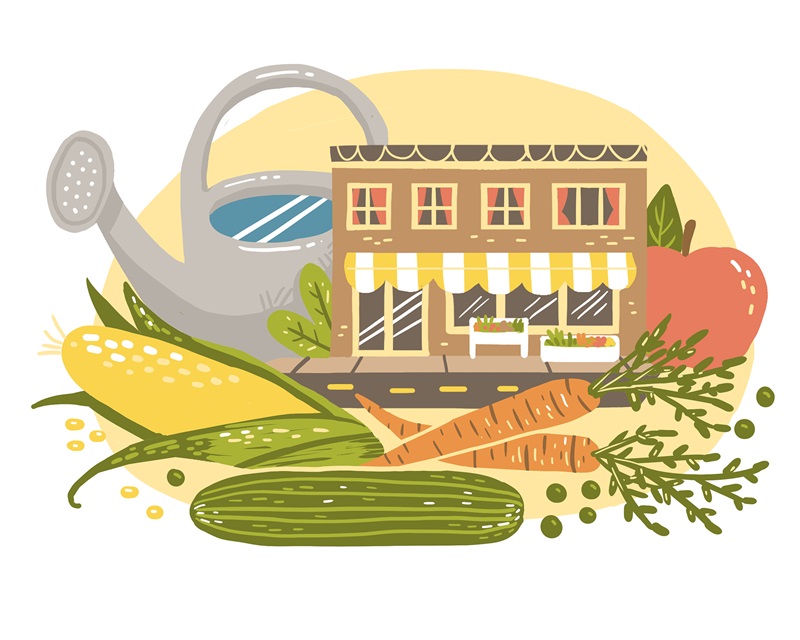
The most visible impact of Northside Fresh partners is the increased availability and prominence of fresh produce and healthy food in North Minneapolis corner stores. But AFC and its Northside Fresh partners have had a wide range of other impacts, too. In a recent report on the initiative, interviewees said the program was also “generating an economic impact, fostering an increased connection to the community, building connections in the community, changing perception and increasing awareness/knowledge [of food issues] and helping change local policy.”6
A natural fit
Collaboration can improve efficiency by eliminating the need for organizations to re-invent the wheel. A Northside Fresh partnership between AFC and NEON offers a good example, and also highlights the important roles that technical assistance and access to capital and credit can play in food-systems work.
Since 2014, AFC has managed Kindred Kitchen, an incubator for food businesses. The shared kitchen offers a commercially licensed food preparation site for everyone from produce aggregators to caterers and would-be restaurateurs. The organization soon realized that many entrepreneurs would need more than a bigger oven to make their businesses sustainable. AFC partnered with NEON to connect food entrepreneurs with business training and opportunities to find credit.
“It was a natural fit,” says Ann Fix, who heads up the food business incubation program at NEON. “Instead of replicating the sort of work they knew we were doing, AFC is working with NEON to provide businesses with the support they need to thrive.”
Fix has firsthand knowledge of how a group like NEON can provide crucial support for a fledgling business. A decade ago, NEON’s business training helped her make a reality of her own small business idea. But the services NEON provides aren’t just for newcomers.
“We have clients come in who have been doing fine without any outside investment for years,” says Fix. “NEON’s goal is to help them reach the next level, whether it is by providing a loan ourselves, connecting them to credit opportunities, or providing other consulting or technical assistance. That may mean providing advice on advertising, or identifying potential new sources of revenue.”
The access to credit and free or low-cost consulting are particularly important in heavily African American communities such as the Northside, Fix says, where many business owners distrust traditional lending institutions. Research suggests that such perceptions about lenders are widespread among people of color. For example, in a 2016 survey by the 12 Federal Reserve Banks, minority business owners from across the country indicated that they were less likely than white business owners to apply for a loan in the first place, because they assumed they would be rejected. The survey also found that black business owners were more likely to report loan denials than white business owners, even when compared to white borrowers with similar risk factors. And when black business owners did acquire credit, they were more likely to report receiving less than they requested.7
Catherine Fleming, a volunteer who has been involved with Project Sweetie Pie for years, notes that the lack of access to capital holds businesses back even when the need is relatively small. “I wish people understood how much of a difference $5,000 can make to entrepreneurs in our neighborhood,” she says.
—Kristen Klingler, Minneapolis Health Department
No silver bullets
A few common themes arise when talking with the people working hard to change the food systems at play in North Minneapolis. There is a deep respect for the diverse approaches toward addressing the complex causes and results of North Minneapolis’s food desert status, and a shared acknowledgement that efforts that don’t incorporate community input will struggle to succeed.
“There is no silver bullet,” says Kristen Klingler, assistant manager of the Minneapolis Healthy Living Initiative at the Minneapolis Health Department. “A new grocery store or more fresh food in corner stores represent important steps, but what’s important for the long term is constant community engagement and a diverse set of tools.”
Many of the nonprofit representatives, public sector officials, and other people working on food in North Minneapolis are quick to list an impressive number of current (and upcoming) projects—and this article only scratches the surface. For example, AFC also operates Breaking Bread Café, a sit-down restaurant in North Minneapolis, and is working on several long-term projects with its partners, including a healthy-food incentive program at grocery stores and a food hub and permanent building for the West Broadway Farmers Market.
Along with the urgency that comes across when many of the people cited in this article discuss the North Minneapolis food landscape, there’s a sense that the changes they are working to create will have an impact across generations.
“As a child, I grew up in a thriving community,” Powell says. “What we’re trying to do is bring that back for my grandchildren and their grandchildren.”
Endnotes
1 Healthy Food Access: A View of the Landscape in Minnesota and Lessons Learned from Healthy Food Financing Initiatives, a report prepared by the Federal Reserve Bank of Minneapolis and Wilder Research and commissioned by the Center for Prevention at Blue Cross and Blue Shield of Minnesota, April 2016
2 Pillsbury United Communities, financial analysis for North Market.
3 A social enterprise is a business that is set up to generate revenue for the support of a social mission. For more on social enterprises, see our January 2009 Community Dividend feature, “Earning income, serving the community: Guidance for building a social enterprise.”
4 SNAP provides a monthly subsidy to low-income families for purchasing food. The federal program, which is administered by the U.S. Department of Agriculture (USDA), is often referred to as “food stamps.” To learn more, visit the USDA’s SNAP information page.
5 For more on the changes to the ordinance, which took effect in April 2015, see this Minnesota Public Radio discussion featuring representatives from the City of Minneapolis and AFC.
6 Impacts and opportunities: Results from a discussion of Appetite for Change’s Fresh Corners project, Wilder Research, April 2015.
7 Small Business Credit Survey: Minority-Owned Firms, Federal Reserve Banks of Cleveland and Atlanta, November 9, 2017.

